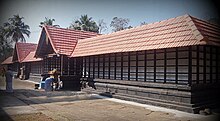Kalady or Kaladi is a town located between Angamaly and Perumbavoor, east of the Periyar river, near to Malayattoor in Ernakulam district of Kerala, India, not far from Cochin International Airport. It is notable as the birthplace of 9th century Indian philosopher Adi Shankara.

The ChottanikkaraDevi Temple is a temple dedicated to the Hindu mother goddess Bhagavati Lakshmi. She is believed to be residing in Chottanikkara (Mahalakshmi) along with her Husband Maha Vishnu. The main deity is also considered as Lakshmi Narayana according to the temple legend. The temple is Classified one among the 108 Abhimana Kshethram of Vaishnavate tradition. The temple is located at Chottanikkara, a southern suburb of the city of Kochi in Ernakulam district, in the state of Kerala, India and is one of the most popular temples in the state. The temple is also known for conducting exorcism.

The Vadakkumnathan Temple is an ancient Hindu temple dedicated to Shiva in Thrissur, in the Thrissur district of Kerala, India. The temple is a classical example of the architectural style of Kerala and has one monumental tower on each of the four sides in addition to a koothambalam. Mural paintings depicting various scenes from the Mahabharata can be seen inside the temple. The shrines and the Kuttambalam display vignettes carved in wood. The temple, along with the mural paintings, has been declared as a National Monument by India under the AMASR Act. According to popular local lore, this is the first temple built by Parashurama, the sixth avatar of Vishnu. Thekkinkadu Maidan, encircling the Vadakkumnathan Temple, is the main venue of the renowned Thrissur Pooram festival.
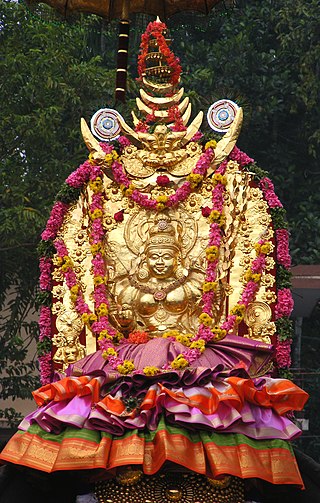
Kumaranalloor is a suburb of Kottayam city, Kottayam taluk, Kerala, India. Kottayam city is just 5 km south of Kumaranalloor. The region was administered by the Kumaranallur grama panchayath till 2010, before the local self-governing body was merged into the Kottayam municipality. The former Panchayath office now exists as the regional administrative office for the municipality. The village is situated on the banks of Meenachil river.
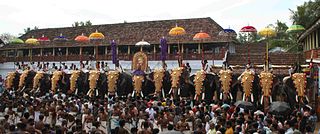
Sree Poornathrayesa temple is a Hindu temple situated in Tripunithura, Kochi, the capital of the former Kingdom of Cochin, Kerala, India. The temple is considered among the greatest temples in Kerala and was the first among eight royal temples of the erstwhile Kingdom of Cochin. The presiding deity is Vishnu as Santhanagopala Murthy or Poornathrayeesa. He was the national deity of Cochin and protector guardian of Tripunithura. Poornathrayeesa is known for his love of elephants. Hence more than 40 elephants participate in his Vrishchikotsavam.

The Aranmula Parthasarathy Temple is a Hindu temple located near Aranmula, a village in Pathanamthitta District, Kerala, South India. It is dedicated to the Lord Krishna, an avatar of Vishnu, who is worshipped as Parthasarathy. Constructed in the Kerala style of architecture, it is one of the "Divya Desams", the 108 temples of Vishnu revered by the Alvar saints.
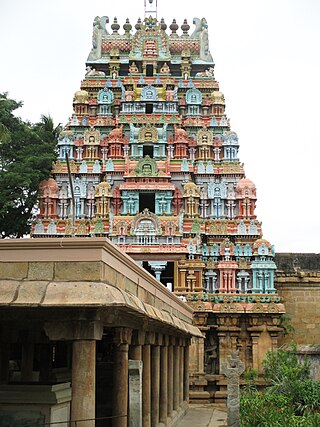
Jambukeswarar Temple, Thiruvanaikaval is a temple of Shiva in Tiruchirapalli district, in the state of Tamil Nadu, India. It is one of the five major Shiva Temples of Tamil Nadu representing the Mahābhūta or five elements; this temple represents the element of water, or neer in Tamil. The sanctum of Jambukeswara has an underground stream.

The Vilwadrinatha Temple is a Hindu temple in Thiruvilwamala, a town in the city of Thrissur, Kerala, India. The principal deities are Rama, the seventh incarnation of the god Vishnu, and his brother, Lakshmana. It figures among the Abhimana Kshetrams in Vaishnavite traditions. This is one of the four major Rama temples in Kerala — the other three are in Thriprayar, Kadavallur, and Thiruvangad. The temple houses an idol of Lakshmana, which is rare in India. Vilwadrinatha Temple is located in the centre of the community of Thiruvilwamala, atop a 100-foot-high hillock. Visible from the temple is Bharathappuzha, the second-largest river in Kerala, which flows past the temple's northern side from around 3 kilometres away.

Ananthapadmanabhaswamy Temple or Ananthapura Lake Temple is a Hindu temple in the middle of a lake in the village of Ananthapura, around 6 km from the town of Kumbla in Manjeshwaram Taluk of Kasaragod District of Kerala, South India. This is the only lake temple in Kerala, and as per some traditions, is believed to be the original seat (Moolasthanam) of Ananthapadmanabha Swami Thiruvananthapuram. It is considered one among the 108 Abhimana Kshethram of Vaishnavate tradition. Legend has it that this is the original site where Ananthapadmanabha settled down.

Anandavalleeswaram Sri Mahadevar Temple in Kollam city is one of the ancient Hindu temples in Kerala, India. Lord Siva and Goddess Anandavally are the main deities of the temple. According to folklore, sage Parashurama has installed the idol of Lord Shiva. The temple is a part of the 108 famous Shiva temples in Kerala. It is located at Anandavalleeswaram, a major neighborhood of Kollam city, that comes to the west side of Kollam Collectorate.
Thumpamon is a village in Pandalam, a part of Adoor thaluk in Kerala, India. One of the greatest attractions of this village is the Achenkovil River, which is known for its natural sceneries along the riverbank. The village relies on non-resident Indian and crops like rubber, coconut, paddy and pepper. The most common crop in the village is rubber. Because of non-resident Indians, this is one of the wealthiest villages in Kerala. Thumpamon is divided into two regions, Thumpamon North and Thumpamon South, by the Achenkovil River.

The Sree Vaikom Mahadeva Temple is a temple dedicated to the Hindu god Shiva in Vaikom, Kerala, India.
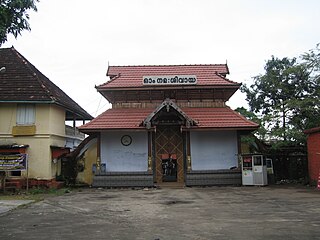
Ernakulam Shiva Temple, also known as Ernakulathappan Temple is one of the major temples of Kerala, located in heart of Ernakulam, Kochi,Kerala, India. The temple, dedicated to Lord Shiva, is considered as the city temple, with the presiding deity as the protector of the city, as per local Hindu faiths and traditions. As per the common practice in Kerala, the deity is reverently called Ernakulathappan, which means Lord of Ernakulam. The temple is located within the Durbar Hall Ground. The temple history itself has deep association with history of the city and was one of the 7 royal temples of Kochi Maharajas. The temple is now under administration of Cochin Devaswam Board. The temple in its current form was built under active patronage of Diwan Sri Edakkunni Sankara Warrier in year 1846 and raised it level of a Royal temple in the Kochi Kingdom. The temple is built on 1-acre (4,000 m2) land. The temple is one of the major Shiva temples in Kerala counted along with the Ettumanoor Mahadevar Temple, Kaduthruthy Mahadeva Temple, Vaikom Temple, Chengannur Mahadeva Temple, Vadakkunathan temple, and Sreekanteswaram Mahadeva Temple, Thiruvananthapuram.

Sree Valayanad Devi Temple dedicated to Bhagavathy, is situated in Valayanad near Kozhikode in North Kerala, India.

Vazhappally Maha Siva Temple is a Hindu temple located in Vazhappally near Changanassery in Kottayam district in the Indian state of Kerala. The temple is administered by the Travancore Devaswom Board. The temple is believed to be constructed by the first Chera king of Kodungallur. The legends suggest that the installation of the idol of god Mahadeva (Shiva) was performed by Parasurama himself. This temple is one among the 108 Shiva temples established by Parasurama. It is one of the few temples in Kerala where two nalambalams and two flag-masts are dedicated. The temple, a Grama Kshetra, also contains some seventeenth century wood carvings depicting figurines from epics. A Vattezhuttu inscription on the northern part of the base of the cultural shrine indicates that the repairs were completed in Kollam Era 840 (1665 AD).

The Thirunakkara Mahadevar Temple situated in the heart of Kottayam is one of the 108 revered Shivalayas in central Kerala, India. The temple is about 500 years old and was built by the Raja of Thekkumkur. It also preserves a number of unique sculptures and murals of various Hindu deities. A common belief is that the idol of Shiva here is installed by Parashurama. The Thekkumkur royal family considered the idol as their paradevatha in the form of "Thirunakkara thevar"

Nariyapuram is a village in Vallicode Panchayat of Pathanamthitta district in Kerala, India. Nariyapuram is located in the northern part of Pathanamthitta. Pandalam, which is seven km away is the nearest town. The district headquarters Pathanamthitta is eight km away. There are regular bus services via Nariyapuram. Schools, hospitals, places of worship and all other necessities are also available. The population here is not too large. There are vast areas of paddy fields and most of the villagers are farmers. Borders of Nariyapuram are Thattayil along the south, Thumpamon along the west, Achankovil river along the north and Kaipattoor along the east. One of the existing sugarcane cultivation in Central Travancore is in Nariyapuram.
Sree Kunninmathilakam Mahadeva Temple is situated at Cheruthazham in Kannur, Kerala. The old name of this temple is Sree Kunninmathilakam Shiva Temple. Shiva of this temple is known as 'Sree Kunninmathilakathappan'. Sree Kunninmathilakathappan is worshipped as Lord Dakshinamoorthy in the morning, Lord Kirathamoorthy at noon, and Lord Umamaheshwara in the evening by devotees.
Kaviyoor is a village located in Thiruvalla Sub-District & Taluk In Pathanamthitta district of Kerala State,India, situated on the western bank of the Manimala River.It Is Located Adjoining Thiruvalla Municipal Town.
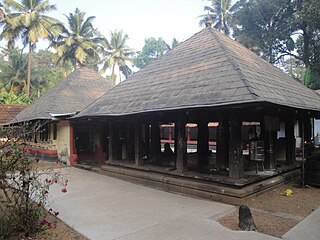
Thiruvatta Mahadeva Temple is an ancient Hindu temple dedicated to Lord Shiva is situated on the banks of the Manimalayar (river) in Thiruvalla of Pathanamthitta District in Kerala state in India. Reference to this temple is found in Vazhappally inscription relates to the rule of Kodungallur Chera king Rama Rajasekhara and temple at Vazhappally. It is the earliest available epigraphical record mentioning a Kodungallur Chera king and written in Malayalam language. According to folklore, sage Parashurama has installed the idol of Lord Shiva in the Treta Yuga. The temple is a part of the 108 famous Shiva temples in Kerala.
